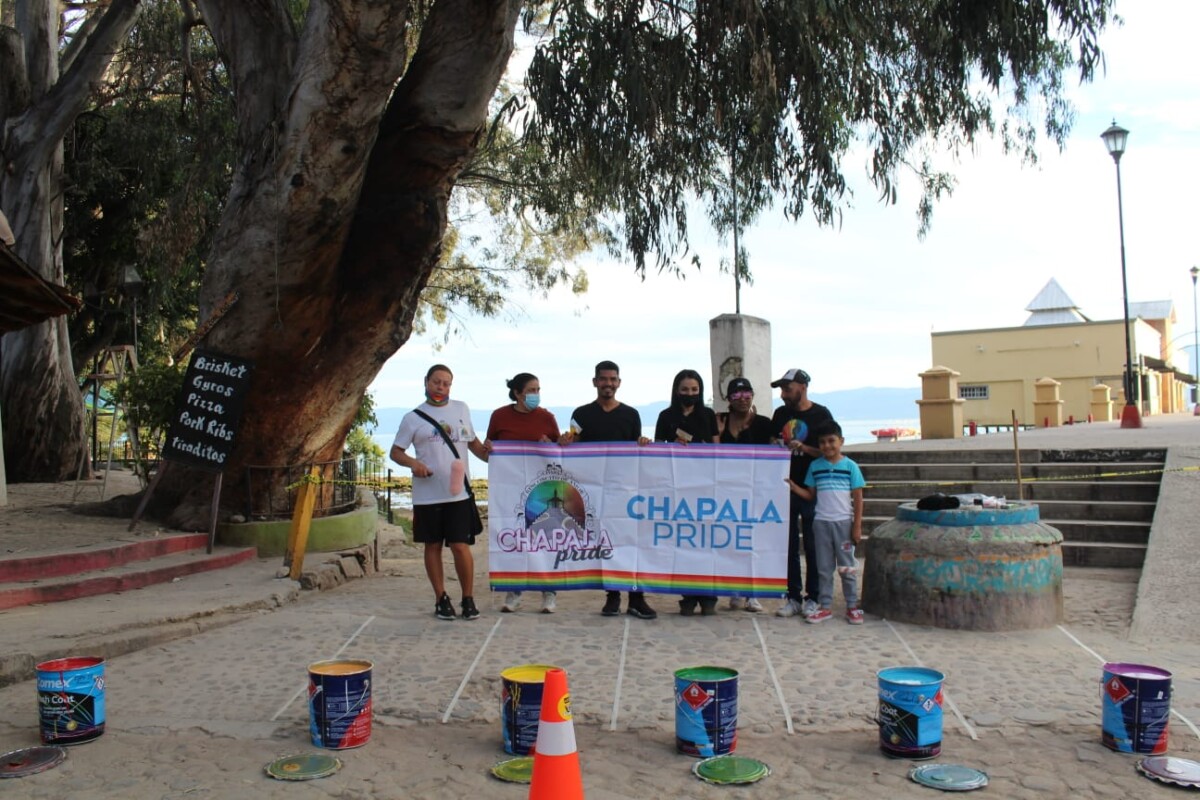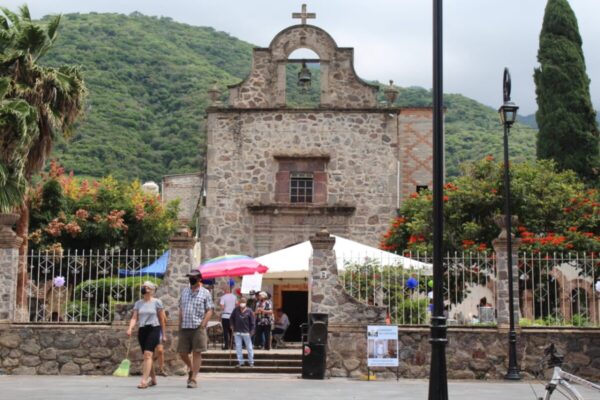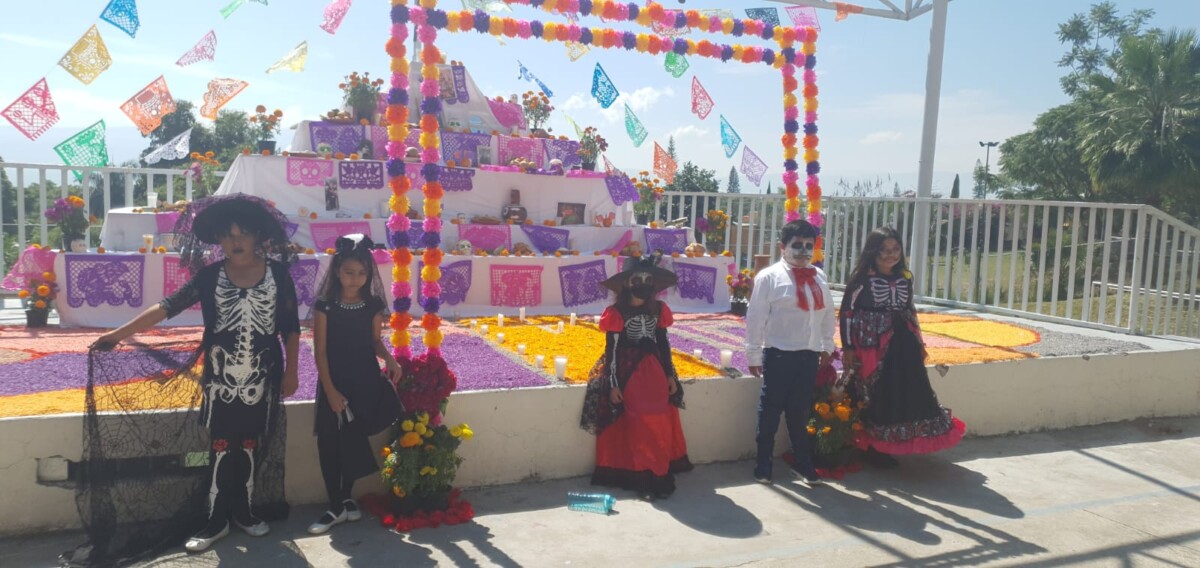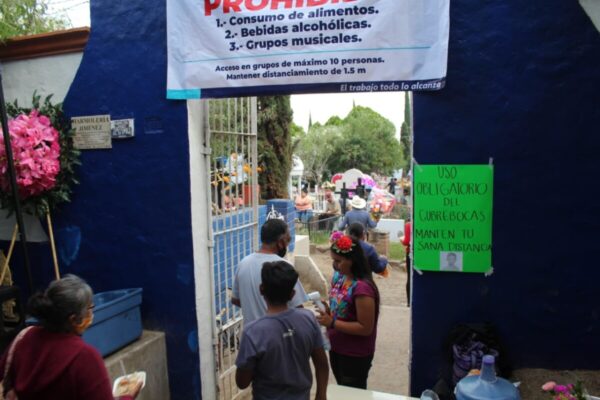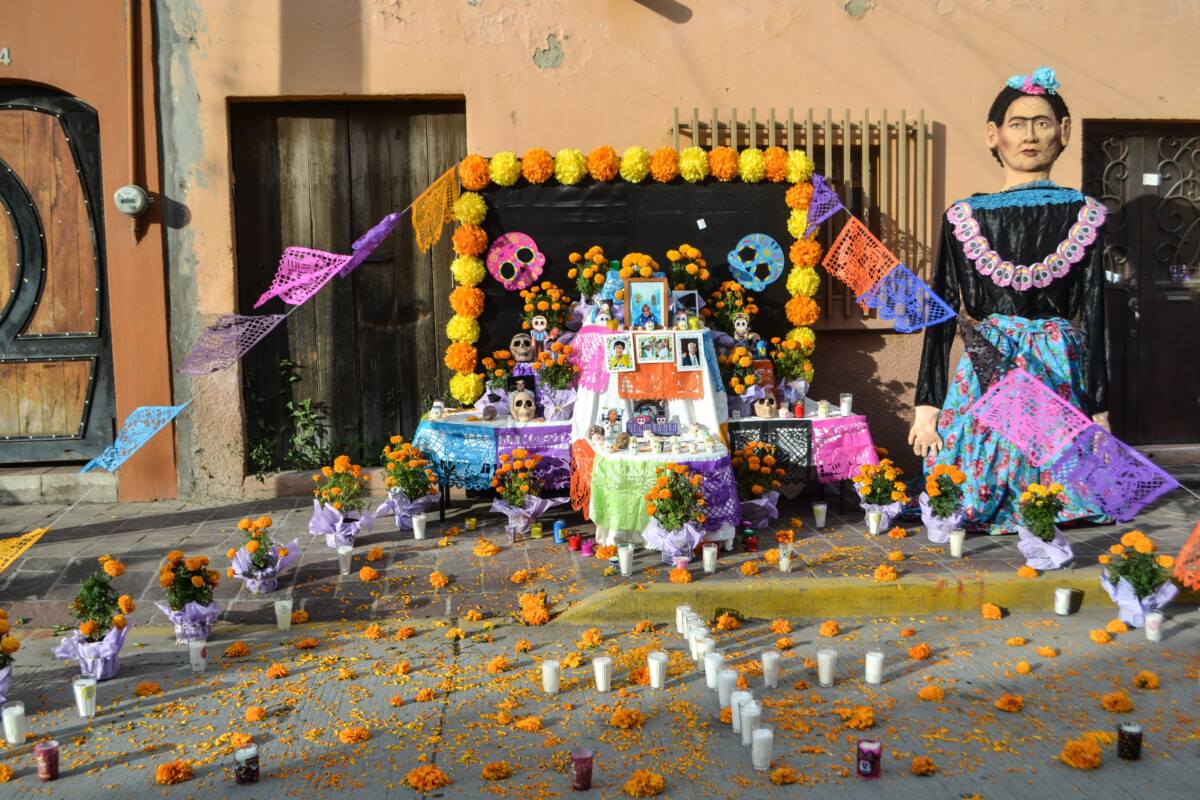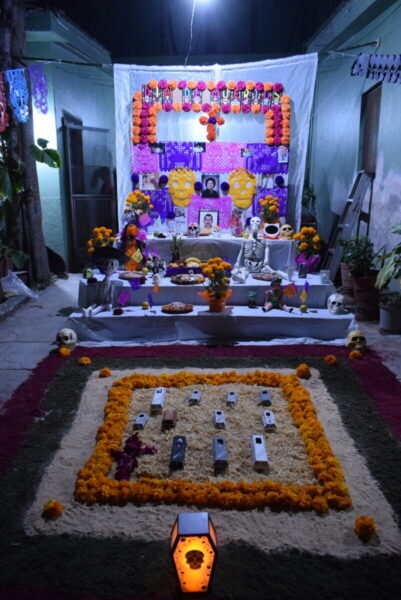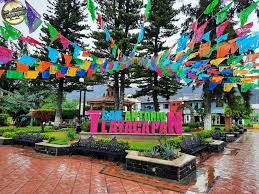identidad
The religious novena honoring St. Andrew the Apostle to be held in traditional manner
The banner listing the program of activities and participating guilds is on the façade of the church of St. Andrew the Apostle.
Sofía Medeles (Ajijic, Jal.)- The novena of nine days of religious celebrations to honor St. Andrew the Apostle will be carried out at the church in the customary way -unlike the celebrations in the main plaza, which will be modified- with the traditional mañanitas, masses, rosaries, and adoration of the Holy Eucharist.
The mañanitas will be held at 7:00 a.m.; while mass will be held at three different times, 8:00 a.m., 12:00 p.m. and 7:00 p.m. Rosaries will be at 6:30 p.m., and adoration of the Holy Eucharist- in the hands of adorers and honorary adorers – will be on Wednesday, November 24, Thursday, November 25 and Friday, November 26.
Translated by Kerry Watson.
Gay activists paint an Ajijic crosswalk with rainbow colors to highlight the LGBTTTIQ+ movement
Participants in the painting of a crosswalk with the colors of the community flag (Johnny Cobián, Noemí Martínez, Delfina Zamora, Cinthia Martínez, Jose Luis Ibarra, and Vanesa Sandoval). Photo: Sofía Medeles
Sofía Medeles (Ajijic, Jal.)- Gay activists painted a zebra crossing with the colors of the rainbow flag Wednesday to make the LGBTTTIQ+ community visible in Lakeside.
Before painting the crosswalk, General director of Guadalajara Pride, Johnny Cobian explained that they were not doing a simple painting, but a political disobedience, a form of protest to tell the residents of Lakeside that they are there, they want to be visible, and, above all, to be respected.
«This action is also to tell our sisters and brothers that they are not alone, because there are those who do not dare to express their sexuality out of fear, so we want to tell them that here we are, fighting shoulder to shoulder, which is one of the objectives of this proud first year in Ajijic, and although they are few, the most important marches began with 10 people. In the future, this will be much bigger than today,» said Cobian.
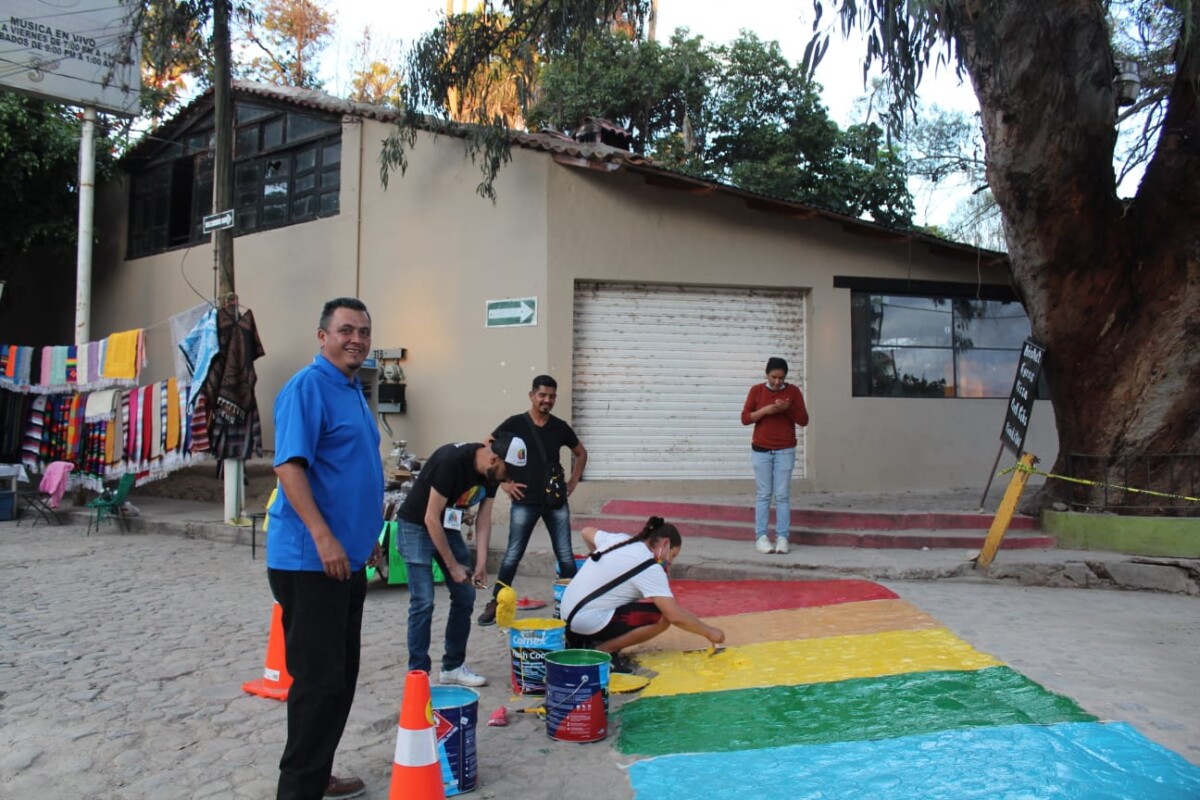
Maximiliano «Max» Macías, who was in charge of the office, showed up to help secure the area while they were painting. Photo: Sofía Medeles.
The action was held in November instead of during the June festivities of the LGBTTTIQ+ community because it celebrated an important event to the Mexican Gay community, the so-called «Dance of the 41», a police raid that took place on November 17, 1901, to arrest a group of 42 men in dresses and ball gowns at a dance., including Ignacio de la Torre y Mier, son-in-law of the then president, Porfirio Diaz, who was spared.
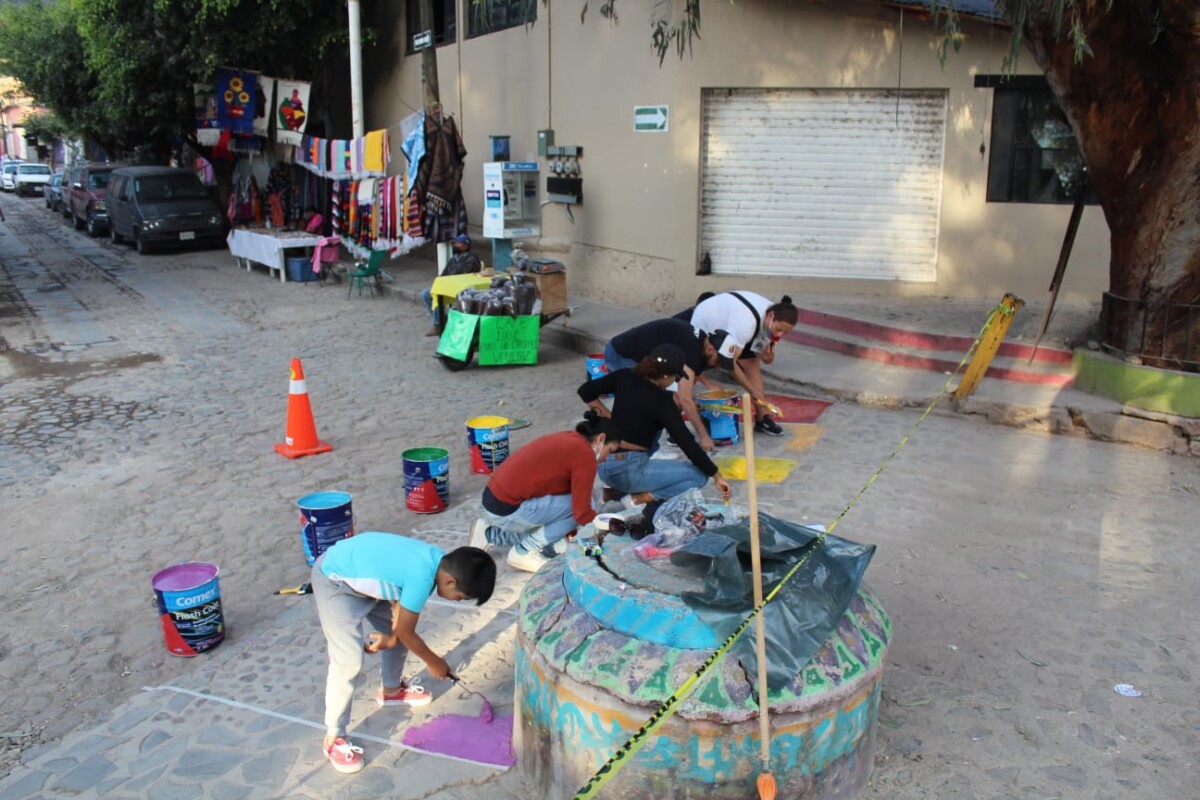
Activists during the painting of the crosswalk. Photo: Sofía Medeles.
The activists invited the people of Chapala both inside and outside the movement to the parade on Saturday, November 20, starting at 4 p.m. in Chapala starting at Cristianía Park and marching through the city to a small festival.
Translated by Patrick O’Heffernan
Chapel restoration project is close to starting
The Chapel of Our Lady of the Rosary, in Ajijic, is close to starting the restoration project
Sofía Medeles (Ajijic, Jal.)- The project for the restoration of Ajijic’s Chapel of Our Lady of the Rosary is very close to starting, and after four fundraising events, the group “Sumando Voluntades” or Summoning Volunteers is ready to take the next step.
Their most recent event was the seventh annual Run for the Rosary, held on the day of the Virgin of the Rosary, October 31, with 180 runners participating in the race. The race and the fair held on the same day raised 40 thousand pesos, giving a total of approximately 350 thousand pesos that the group has raised to start working.
The architect in charge of the project, Josué Ramos, said that the restoration project was presented to the National Institute of Anthropology and History (INAH) and needs some modifications, however, the capital raised is enough to get started.
«They asked us to revise the structural project to the specifications provided by the architect of the INAH. The architect said that we don’t have to spend all the capital in the first stage since they were quite simple things to start with,» Josué asserted.
He also added that they have more events in mind, although they have yet to plan the details or set the date. In the short term, they plan to focus on the architectural survey and the necessary restructuring.
«We will continue to raise funds for this project. For the moment, we are thinking of selling a black and white poster with the Virgin of the Rosary and the little chapel in the background, which we will start selling during the patron saint festivities and whenever we have the opportunity», concluded the architect Josué.
Translated by Kerry Watson.
Terranova Institute celebrates its Day of the Dead festival like never before
The preschool, elementary and high school students prepared a catwalk in which they wore their Catrinas, Catrines and skeleton costumes.
Instituto Terranova Writing Workshop. – The Terranova Institute celebrated the Day of the Dead like never before with the creation of an altar of the dead, a costume parade, folkloric dance numbers, and an aerial dance, among other activities. Nine art and sports workshops allowed all students to participate and watch the events.
The preschool, elementary and high school students prepared a catwalk in which they wore their Catrinas, Catrines and skeleton costumes. Chess students performed a game with living pieces.
Students of the music workshop enlivened the festival with songs, while the students of the Acrobatics workshop performed a surprising display of their rope skills. No less surprising was the aerial dance workshop.
Teachers and students made a six-level altar featuring a colorful sawdust mat, floral offerings, pan de muerto, sugar skulls, different dishes, and the typical papel picado, as well as photographs of loved ones.
Translated by Elisabeth Shields.
Celebration and color returned to the Ajijic cemetery
On November 1 and 2, the cemetery was open from 8:00 am to 8:00 pm with a Covid checkpoint at the entry.
Sofía Medeles (Ajijic, Jal.)– Unlike last year when the municipal cemetery only allowed people to enter to clean the tombstones, this year people were able to decorate the graves of their relatives who have passed away and spend some time together.
The doors of the cemetery were kept open from 8:00 a.m. to 8:00 p.m. on November 1 and 2, and strict Covid checkpoints were maintained at the entrance. Visitors were required to wear masks and many did, and sanitizing gel was provided. In addition, Civil Protection personnel were on hand to assist.
«It is a beautiful tradition that year after year we try not to lose, besides being a moment of uniting with our living and our dead. I met many people that I know here and we were happy that this year the cemetery was more accessible and we could stay longer. And we found a very clean cemetery», said one of the Ajijic residents who was at the cemetery.
Inside the cemetery, people were busy cleaning and decorating the tombs, as well as sitting and socializing among families. Every grave, even the oldest and most forgotten, had at least one flower. Outside the cemetery flowers and food were on sale.
The person in charge of the office, Maximiliano «Max» Macías Arceo, said that elements of civil protection and public security were patrolling the cemetery. He also said that there were no mishaps and that people followed the requirements and respected the hours of service.
«The cemetery was not closed as such, because the gate to the stream is missing, but at the time (of closing) people were invited to leave and there were no problems. There were no altercations or mishaps», said Maximiliano «Max» Macías.
Also, on November 2, the cemetery closed one hour later by order of the Chapala City Hall, so that the families had the opportunity to leave their graves ready and clean of the garbage they may have generated during that afternoon.
Translated by Amy Esperanto.
Day of the Dead festival goes on in Jocotepec despite attempts to close it
Altar accompanied by the iconic Frida Khalo. Photo: Héctor Ruíz.
Héctor Ruíz Mejía – Despite municipal authorities nearly closing the festival «Al fin, para morir nacimos» («In the end, we were born to die»), the event for the Day of the Dead was held in Jocotepec, moving some local residents to tears.
According to Carlos Cuevas, ex former director of Casa de la Cultura José Vaca Flores, who was one of the organizers of the event, the new director of the highway system, Aguirre (who had not even been sworn in yet), tried to close the event, arguing that the appropriate permits had not been requested.
Cuevas explained that the road personnel argued that they lacked the Civil Protection review and that according to him, «it was in their power to cancel the permit if they wished.» However, Civil Protection rose to the call to provide support to the event so the event could proceed.
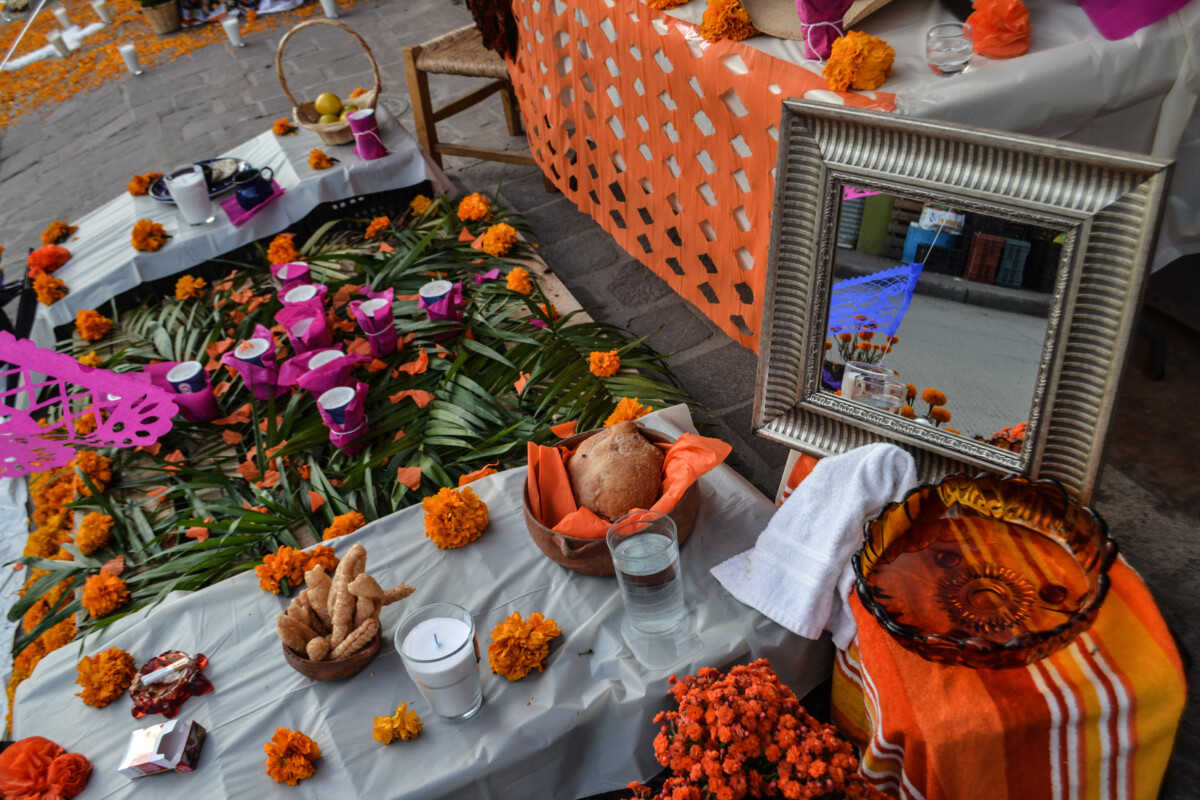
Sample of one of the altars on Morelos Poniente street. Photo: Héctor Ruiz.
The first edition of the festival took place last Sunday, October 31 on Morelos Poniente Street, where in addition to enjoying typical music and spectacular performances by students from the School of Performing Arts of the University of Guadalajara (UdeG), dozens of people witnessed the stories on the 11 altars that the community itself erected along the street.
One of the altars was made by the Ibarra Campos family to honor their father, Goyo. He was described as a cheerful man, a cab driver, who enjoyed life, as well as atole and chicken. These stories brought the audience into the stories themselves of those who lived before them.
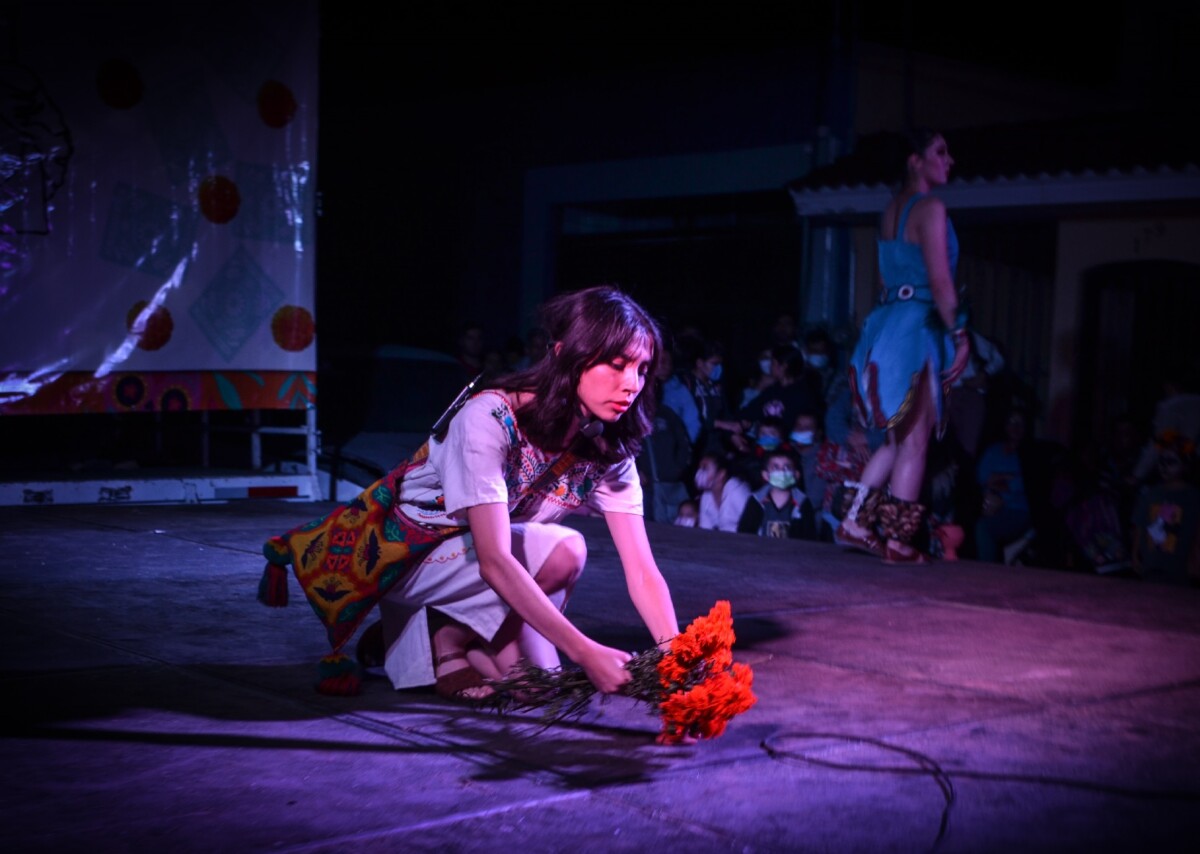
Sample of one of the altars on Morelos Poniente street. Photo: Héctor Ruiz.
«Because we are not only united in death, but also in life,» Carlos said, adding that everyone contributed a little or a lot, like the ladies of the neighborhood, who for two weeks set up the two portals covered with marigold flowers located at both ends of the street.
«It was incredible to see how all the people came together to make the event, from people who supported with 20 pesos, to those who anonymously supported with up to ten thousand pesos,» explained Carlos.
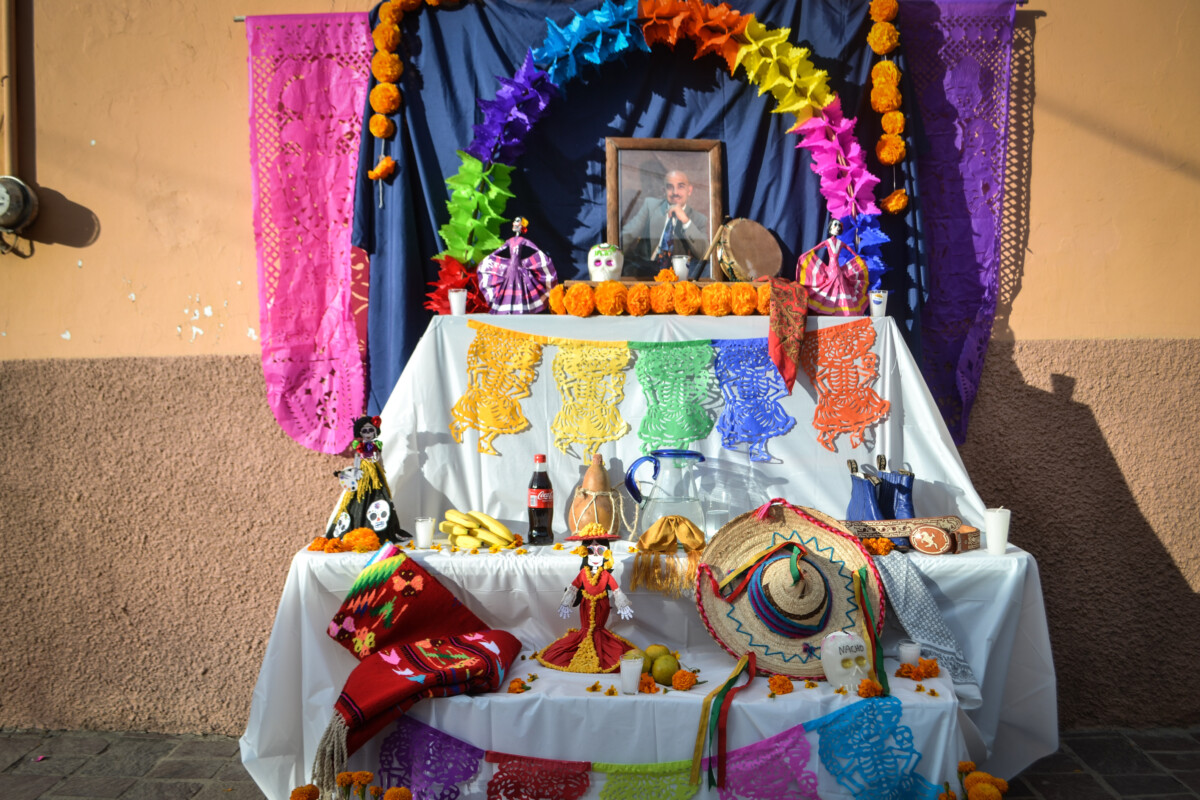
Sample of one of the altars on Morelos Poniente street. Photo: Héctor Ruiz.
«The truth is I didn’t know what to expect, I was in the plaza and I started to hear that they were coming here, so I came to see what was going on and I really had a good time», commented Ramón. He said that he couldn’t stop laughing from the Chiapas death jokes in one of the plays.
The first edition of the festival in commemoration of the Day of the Dead was packed with a large turnout which exceeded all the expectations of the organizers and the community which longed to celebrate this date after a year of inactivity.
Translated by Kerry Watson.
Altar display returns to 5 de Mayo Street in Chapala as its founder seeks to bring back its splendour
This is the completed altar presented by the neighbours of Calle 5 de Mayo. Jazmín Stengel.
Jazmín Stengel – After retiring from the organization in 2016, the founder of the traditional altar display, Cristina Flores, has returned to take the reins of the organizing committee. The annual exhibition of altars for the Day of the Dead on 2 November was once again held on 5 de Mayo Street in the municipal capital of Chapala.
Despite the low participation in the last two years due to Covid-19 health emergency measures, 20 families responded to Cristina’s invitation this year, but only 16 altars were set up in total. With candles, food, music, and depictions of the people, many of whom died during the pandemic.
In the exhibition’s best years, up to 130 altars were set up along the street, including altars from the parish of San Francisco de Asís and institutions such as schools, the Red Cross, DIF Chapala and the Chapala Regional High School, who regularly compete in the Vida y Muerte festival.
Although Civil Protection only estimated around 150 spectators between 8:30 and 10:00 p.m., the altar display (and contest by the high school) became known as the largest in Jalisco, according to the State Government, both in terms of the number of altars and visitors, gathering more than five thousand people at a time. «And it will be the same again,» said Mrs. Flores, who said she has already begun to extend invitations to different institutions for next year.
The 16 altars that were presented were the same for the last two years, altars that neighbours from the block set up in their backyards, garages or on the pavement outside their homes and that have kept the tradition alive despite health restrictions. This year was no exception and, although with more dark spaces than light, the few neighbours who participated continued to offer tea, canelita and sandwiches to the few spectators.
Professor David Castellanos of the Chapala Regional High School, who is in charge of organizing the celebrations on these dates, said that he is keeping alive the hope of presenting the Vida y Muerte contest again, along with the display of altars on 5 de Mayo Street.
Translated by Dee Lynn
Buscan generar la identidad cultural del pueblo
Foto: Cortesía.
Sofía Medeles (Ajijic, Jal.)- A través de un proyecto cultural, que incluye a un colectivo de artistas, buscarán dar identidad al pueblo de San Antonio Tlayacapan, dijo Octavio Ignacio Pérez, encargado del área de cultura de la delegación.
“Una de las cuestiones necesarias y difíciles, es la generación de la identidad cultural del pueblo; la falta de ella hace que el pueblo no sea muy tomado en cuenta, entre los habitantes no se sabe quién hace qué. Esperemos que con cuestiones históricas y de memoria, se pueda generar esta identidad o aportar al menos un sentido”, señaló Octavio.
El delegado compartió que su plan de trabajo de los primeros cien días y en coordinación con Santiago Baeza, director de cultura de Ajijic y San Antonio, comprende la elaboración de un proyecto para crear talleres, por ejemplo, de lectura, artes plásticas; además de festivales, la creación de una biblioteca y colaborar con el recién inaugurado Museo Comunitario de San Antonio Tlayacapan.
También, pretende que en la delegación se realicen murales, promover el arte urbano e intercambios culturales y artísticos. Además, darle enfoque a los monumentos, como la torre de la Escuela Primaria Cuauhtémoc y generar información sobre la historia del lugar, para compartirla con visitantes e incluso con los mismos pobladores.
Respaldado por la comunidad, funcionarios y artistas, Octavio Pérez se siente preparado para emprender este proyecto que traerá color y movimientos culturales y artísticos en la comunidad. Aunque dijo que los primeros cien días es poco tiempo, espera que se den los primeros pasos de este ambicioso proyecto. Actualmente, el delegado está buscando espacios con las condiciones necesarias para el desarrollo de las actividades.
Las convocatorias se anunciarán por medio del Facebook de Cultura Tlayacapan y San Antonio Tlayacapan; además, Octavio señaló que se encuentra esperando la conformación de una radio comunitaria donde podrán dar más difusión.
El dato:
Octavio Ignacio Pérez, es originario de Chapala, pero la mayor parte de su vida ha residido en San Antonio, además de que su familia es originaria de ahí, se ha mantenido entre Jalisco, Hidalgo y San Luis Potosí.
Durante los últimos 18 años se ha dedicado a la educación popular, con trabajos de intervención social y cultural para niños, docentes, jóvenes, pacientes psiquiátricos, etcétera. Así como talleres y colectivos en San Luis Potosí; también colaboró con el museo comunitario Atotonilli en Hidalgo, donde también trabajó en cuestiones sociales y educativas.
En cuanto a su oficio, dice que es tapicero de muebles domésticos, se dedica a la cartonería y la literatura enfocada en poesía. Es editor de la revista digital Campos y Plumas, y pese a haber trabajado para las dependencias de cultura en San Luis Potosí e Hidalgo, es su primera vez como funcionario.
Chapala’s muted celebration of St. Francis of Asis
The image of St. Francis of Assisi went on its route accompanied by few parishioners, in addition to the guilds that stand guard for him every year.
Jazmín Stengel: Although the ecclesiastical authorities asked people to watch the procession from their homes online, «on the very day» of the festivities, October 4, the people of Chapala opted to hire their own norteño band and celebrate their patron saint San Francisco de Asisi, as they do every yea in front of the parish church of Chapala,

Due to the pandemic this year there was no party or children’s bouncy castle, but that did not stop a group of young people to celebrate as usual, with a norteño band they hired. The band Loma Santa which usually accompanies the saint every year on his journey) left after playing a couple of songs in front of the esplanade after mass.
The procession of the «mero día» was led by Danza San Francisco, followed by Danza San José, both from Chapala, and finally, Danza Quetzalli del Señor de la Salud from San Luis Soyatlan. The Mariachi Aguila, who for the seventh consecutive year accompanied the saint, could not miss the event either, as well as the marching band San Francisco de Asisi with a special guest, the Marching Band of the Señor de la Misericordia de Ocotlán.
This was how the guild of San Judas Tadeo closed the festivity o San Francisco de Asisi, the patron saint of Chapala, t a muted celebration, but the date was not left unnoticed by the people of Chapala.
Translated by Patrick O’Heffernan
Crónicas de la ribera: Dios nunca muere
El carro alegórico está a punto de salir. Una adolescente representa a un ángel que custodia la imagen. Foto: Maria del Refugio Reynozo Medina.
Por: Maria del Refugio Reynozo Medina
El Rosario
El agudo sonido del clarinete se acompaña con la algarabía de las trompetas y resuenan las mañanitas, en medio del altar principal del Templo en San Pedro Tesistán. Las notas de Celebremos y Mi Virgen Ranchera invaden el recinto que además, está desbordado de flores.
Hoy es quince de agosto, día de la Virgen de la Asunción. A las seis de la mañana el templo de San Pedro Tesistán, luce repleto de asistentes, un centenar de personas se congregan para cantar y rezar a la pequeña imagen de la Virgen Maria que fue asunta al cielo.
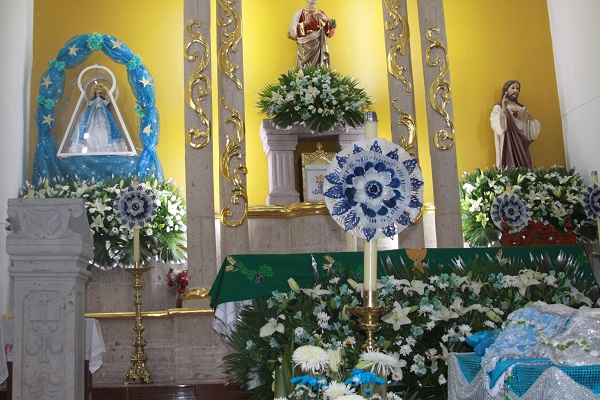
El altar del Templo de San Pedro Tesistan engalanado para celebrar a la Virgen de la Asunción. Foto: Maria del Refugio Reynozo Medina.
Todas las miradas están puestas en la delicada figura de la virgen, que porta un esplendoroso ropaje blanco con un manto azul celeste. La fina silueta cubierta de encajes y piedras emite destellos fulgurantes. Tiene los brazos extendidos y mira al frente con una sutil sonrisa, los ojos y las cejas están finamente delineadas y el cabello negro que cae sobre sus hombros, ligeramente rizado luce decorado con un par de broches brillantes. La imagen de la virgen que no alcanza el metro de altura, está coronada con oro y a sus espaldas lleva un resplandor centelleante. Observa a los feligreses desde su trono a la derecha de la imagen de San Pedro Apóstol con expresión de ternura, como respondiendo a las plegarias y cantos derramados por los fieles.
Las angélicas legiones
cantan con gran armonía
entonando dulces canciones
de las flores de Maria.
Refugio de pecadores
eres virgen soberana
te saludo entre las flores
antes de romper el alba.
Las voces femeninas entonan los cantos y la banda las acompaña al final de cada estrofa ahora desde el atrio.
Mientras tanto, afuera se preparan dos mesas con pan dulce, canela y rompope para ofrecer a los asistentes.
-Alabemos y demos gracias en cada instante al santísimo y divino sacramento-Finaliza el Rosario y la gente se encamina a la salida del templo al encuentro de las ollas de canela humeante.
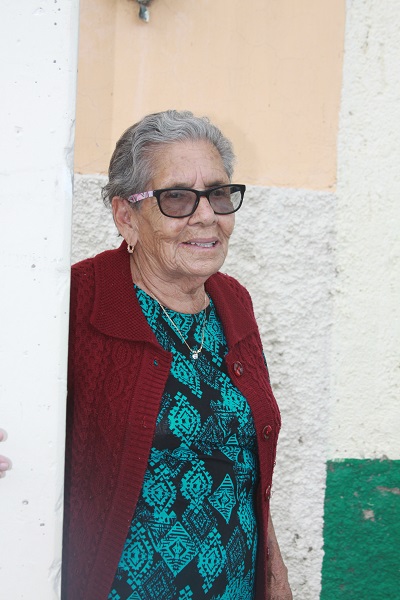
Fidela Garate lleva sesenta años a cargo de la decoración del carro que lleva a la imagen de la Virgen de la Asunción. Foto: María del Refugio Reynozo Medina.
La banda comienza a entonar valses y los fieles comparten la canela entre breves conversaciones.
-Esta fiesta es de mujeres- dice una de las colaboradoras.
Cada día del novenario está asignado a una encargada que tiene ayudantes, pues hay que pagar la pólvora de los fuegos artificiales, las flores del templo, la música, las misas y los alimentos que se ofrecen en el rosario y la comida para los músicos.
La mujer encargada, pagó cuatro mil doscientos pesos por los cohetes de la misa de función.
Muchos cargos se heredan o “se pasan” cuando económicamente no es posible cubrir los gastos.
A Celina Robledo Valencia le dijo su mama:
-Ya eres mayor de edad ya te voy a apuntar para ayudar-
Zaira Ramírez Reynoso es ayudante desde que aún estaba en el vientre de su madre, cuando la encargada le dijo -Si es niña, se la pido desde ahora-.
***
Misa de Función
A las doce del día ocurre un acto solemne, la Misa de Función armonizada por el mariachi y los asistentes ataviados con el estreno o las prendas más elegantes.
En este lugar, la explosión de un cohete en medio del celeste cielo equivale a un estallido de alegría muy dentro del corazón.
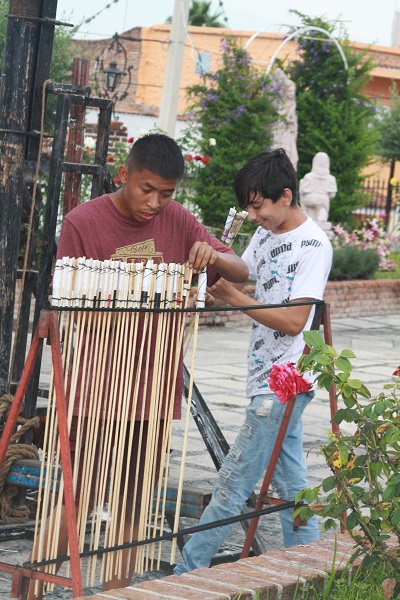
Jovenes preparán los cohetes. Foto: María del Refugio Reynoso.
***
La procesión
Fidela Garate, lleva sesenta años arreglando el carro donde se lleva a la imagen de la virgen en la procesión.
-Dicen que esta fiesta es de mujeres pero también los hombres ayudan-
Me dice mientras observa cómo sus ayudantes, (entre ellas, un hombre) terminan los detalles del carro donde irá la imagen.
Ella con un pequeño grupo de mujeres ha comprado cortinas y telas para decorar el vehículo que lleva por las calles la venerada imagen. Tenía veintidós años cuando le encargaron esa misión.
Ese cargo es una responsabilidad que le da orgullo, más también hay que asumir los gastos, pagar la pólvora que se utilizará en el recorrido que cuesta unos ocho mil pesos. El cobro por las flores del templo llega a nueve mil pesos. Para la procesión el pago de la danza es de seis mil pesos y seis mil más por la banda de guerra.
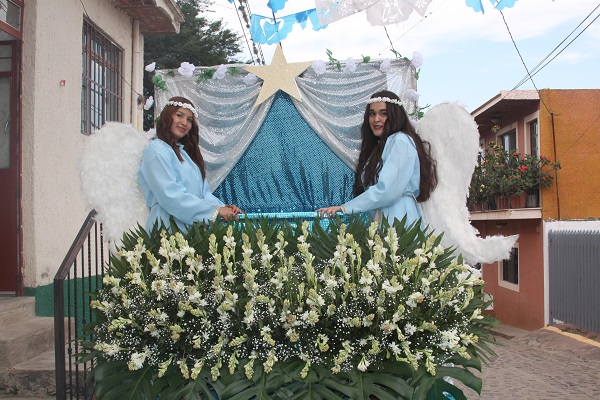
El carro listo se encamina para recoger la imagen de la Asunción. Foto: María del Refugio Reynozo Medina.
Desde que era niña, Fide recuerda la fiesta de la Asunción, no había plaza, sólo un tubo de metal en el centro de un espacio despoblado en donde hoy se coloca la plaza; ahí la gente ya se reunía al anochecer y la banda tocaba, recuerda que era la banda de San Cristóbal. No había energía eléctrica y la serenata se llevaba a cabo iluminada por lámparas, aparatos de petróleo y hasta lumbradas.
-Mientras Dios nos deje tendremos ayuda. Dice confiada cuando hablamos de números.
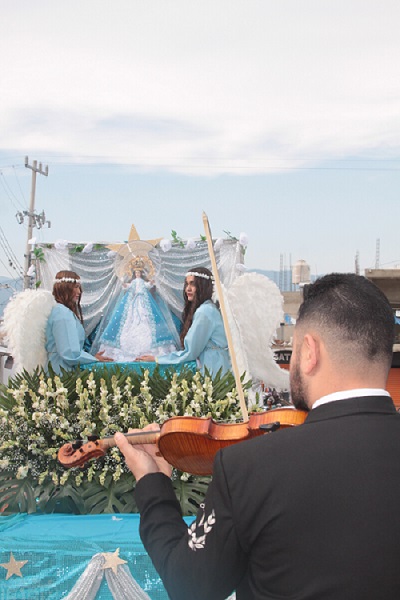
El mariachi acompaña la imagen en el recorrido. Foto: María del Refugio Reynozo Medina.
El carro está listo, un enorme ramo de nardos decora la plataforma de la camioneta forrada con un fondo azul satinado y cortinas plateadas. En el respaldo lleva una estrella al fondo y dos franjas de tela plateada plisadas en los lados. Dos adolescentes están vestidas de ángeles y suben al vehículo con sus impecables túnicas celestes y una corona de flores blancas en la cabeza. Ellas custodiarán la imagen en el recorrido.
En la plaza los danzantes ya se preparan, se colocan los detalles de los trajes. Un mariachero se acomoda el moño y se mira el peinado por el retrovisor de una camioneta.
Ya son las seis de la tarde y aunque el Señor Cura Carlos Enrique dijo en la homilía que no habría procesión como cada año, debido a la contingencia sanitaria por el COVID, la gente se acerca para acompañar a la imagen.
-Animo muchachos que se vea la religión- dice un mariachero a otro
Y comienza la procesión.
En el recorrido de una hora y media se van sumando más personas, adultos y niños.
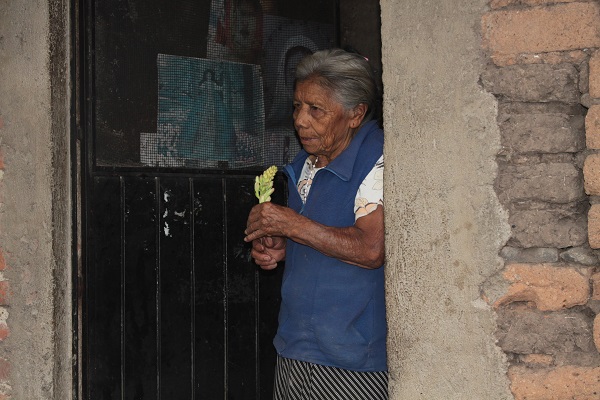
Una mujer sostiene un nardo que lleva la bendición de la imagen. María del Refugio Reynosa Medina.
En algunas casas se detiene la procesión y los adultos mayores o enfermos, pueden contemplar a la pequeña imagen. Un muchacho arranca un nardo del ramo y lo entrega a una mujer que mira absorta la imagen, un hombre mayor desde un balcón observa con un fervor casi al punto del llanto.
A la mitad del peregrinar, subimos a la carretera, los monaguillos desfilan con sus ropajes color crema que se mueven con el aire que dejan los coches avanzando por el carril derecho.
El asfalto que hace unos minutos lucía repleto de autos es ahora el escenario de un danzante que desliza su estilizada figura al sonido del tambor y el caracol. Los cuerpos con los coloridos trajes y penachos de plumas brillantes aparecen barnizados por el sudor de más de una hora de movimientos dancísticos.
Pasan las siete de la tarde y el sol muere en los montes como en el vals de Macedonio Alcalá (Dios nunca muere) que entona el mariachi, en medio del asfalto, ahora vacío de carros y lleno de cánticos y fe.
San Pedro Tesistán, 15 de Agosto de 2021
© 2016. Todos los derechos reservados. Semanario de la Ribera de Chapala

